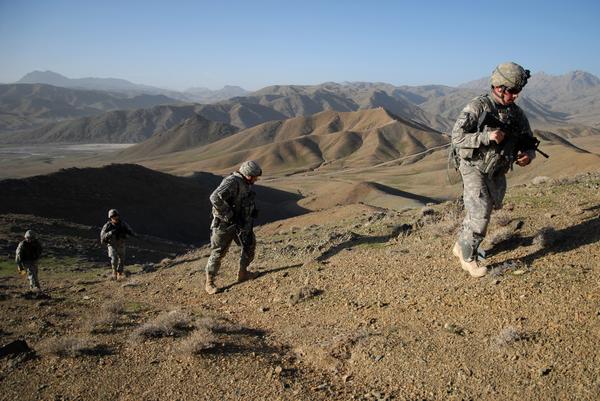Correction Appended
Two years after the Taliban fell to an American-led coalition, a group of NATO ambassadors landed in Kabul, Afghanistan, to survey what appeared to be a triumph — a fresh start for a country ripped apart by years of war with the Soviets and brutal repression by religious extremists.
Multimedia
With a senior American diplomat, R. Nicholas Burns, leading the way, they thundered around the country in Black Hawk helicopters, with little fear for their safety. They strolled quiet streets in Kandahar and sipped tea with tribal leaders. At a briefing from the United States Central Command, they were told that the Taliban were now a “spent force.”
“Some of us were saying, ‘Not so fast,’ ” Mr. Burns, now the under secretary of state for political affairs, recalled. “While not a strategic threat, a number of us assumed that the Taliban was too enmeshed in Afghan society to just disappear.”
But that skepticism had never taken hold in Washington. Since the 2001 war, American intelligence agencies had reported that the Taliban were so decimated they no longer posed a threat, according to two senior intelligence officials who reviewed the reports.
The American sense of victory had been so robust that the top C.I.A. specialists and elite Special Forces units who had helped liberate Afghanistan had long since moved on to the next war, in Iraq.
Those sweeping miscalculations were part of a pattern of assessments and decisions that helped send what many in the American military call “the good war” off course.
Like Osama bin Laden and his deputies, the Taliban had found refuge in Pakistan and regrouped as the American focus wavered. Taliban fighters seeped back over the border, driving up the suicide attacks and roadside bombings by as much as 25 percent this spring, and forcing NATO and American troops into battles to retake previously liberated villages in southern Afghanistan.
They have scored some successes recently, and since the 2001 invasion, there have been improvements in health care, education and the economy, as well as the quality of life in the cities. But Afghanistan’s embattled president, Hamid Karzai, said in Washington last week that security in his country had “definitely deteriorated.” One former national security official called that “a very diplomatic understatement.”
President Bush’s critics have long contended that the Iraq war has diminished America’s effort in Afghanistan, which the administration has denied, but an examination of how the policy unfolded within the administration reveals a deep divide over how to proceed in Afghanistan and a series of decisions that at times seemed to relegate it to an afterthought as Iraq unraveled.
Statements from the White House, including from the president, in support of Afghanistan were resolute, but behind them was a halting, sometimes reluctant commitment to solving Afghanistan’s myriad problems, according to dozens of interviews in the United States, at NATO headquarters in Brussels and in Kabul, the Afghan capital.
At critical moments in the fight for Afghanistan, the Bush administration diverted scarce intelligence and reconstruction resources to Iraq, including elite C.I.A. teams and Special Forces units involved in the search for terrorists. As sophisticated Predator spy planes rolled off assembly lines in the United States, they were shipped to Iraq, undercutting the search for Taliban and terrorist leaders, according to senior military and intelligence officials.
As defense secretary, Donald H. Rumsfeld claimed credit for toppling the Taliban with light, fast forces. But in a move that foreshadowed America’s trouble in Iraq, he failed to anticipate the need for more forces after the old government was gone, and blocked an early proposal from Colin L. Powell, then the secretary of state, and Mr. Karzai, the administration’s handpicked president, for a large international force. As the situation deteriorated, Mr. Rumsfeld and other administration officials reversed course and cajoled European allies into sending troops.
When it came to reconstruction, big goals were announced, big projects identified. Yet in the year Mr. Bush promised a “Marshall Plan” for Afghanistan, the country received less assistance per capita than did postconflict Bosnia and Kosovo, or even desperately poor Haiti, according to a RAND Corporation study. Washington has spent an average of $3.4 billion a year reconstructing Afghanistan, less than half of what it has spent in Iraq, according to the Congressional Research Service.
The White House contends that the troop level in Afghanistan was increased when needed and that it now stands at 23,500. But a senior American commander said that even as the military force grew last year, he was surprised to discover that “I could count on the fingers of one or two hands the number of U.S. government agricultural experts” in Afghanistan, where 80 percent of the economy is agricultural. A $300 million project authorized by Congress for small businesses was never financed.
Correction: August 14, 2007
A front-page article on Sunday about how security and rebuilding efforts in














